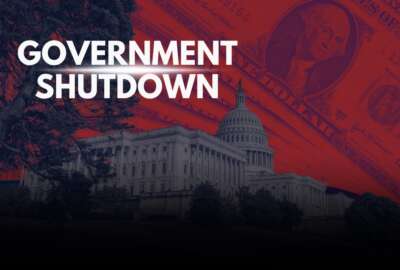Beyond Schedule F, Trump has ‘arsenal’ of ways to target federal employees
If the Trump administration is stalled in implementing Schedule F, experts say it has other levers to pull to target federal employees.
Worried about Schedule F and the future of your job? Excited to see if DOGE can improve government efficiency? Want to know more about the proposed pick to head up your department? Federal News Network is tracking all things transition-related, as the 47th administration’s plans for the federal workforce take shape. Visit our Tracking the Transition page to keep up with the latest developments.
President-elect Donald Trump led policies during his first term in the White House that made it easier to fire large swaths of the federal workforce.
On the campaign trail, Trump and his supporters have promised to revisit these policies if reelected — especially an 11th-hour executive order that would have reclassified thousands of federal employees as “Schedule F” positions exempt from civil service protections.
President Joe Biden rescinded Trump’s Schedule F executive order during his first week in office.
Earlier this year, the Office of Personnel Management finalized a regulation that would make it harder for any subsequent administration to resurrect it.
Federal workforce experts, however, warn these are not durable barriers, and that a second Trump administration can still implement Schedule F without facing many hurdles.
OPM’s final regulation, at best, may set up legal and administrative challenges that could delay, but not stop, the return of Schedule F.
Don Kettl, professor of public management and public policy at the University of Texas at Austin, said the Biden administration’s efforts to prevent the return of Schedule F amount to a “speed bump, at best.”
“The Biden administration tried to put up roadblocks, but they’re the kinds of things that you always see in the old police movies, where the speeding car comes up the roadblock and just crashes right through,” Kettl said.
Even if the Trump administration is stalled in implementing Schedule F, experts say the Trump administration has other levers to pull, when it comes to putting punitive measures on individual federal employees or agencies.
Among them, OPM has yet to finalize guidance that would keep agencies from putting federal employees on indefinite paid administrative leave.
Congress passed the Administrative Leave Act to put tighter restrictions on how long agencies can put their employees on paid administrative or investigative leave. But OPM is more than seven years late in providing guidance to agencies on how to implement the legislation.
Public Employees for Environmental Responsibility (PEER) filed a lawsuit against OPM this summer, urging the agency to complete the long-awaited Administrative Leave Act guidance.
PEER Executive Director Tim Whitehouse told Federal News Network that, absent OPM’s guidance, the Trump administration would have more latitude to put certain federal employees’ careers in limbo.
“I would expect that the Trump administration would use this tool as their first step in getting their people into civil service positions,” Whitehouse told Federal News Network.
Under the legislation, agencies can put employees on investigative or notice leave for up to 10 days, but can extend that period incrementally up to a 90-day maximum. Agencies would have to report administrative leave lasting more than 90 days to Congress.
PEER’s lawsuit cites examples where federal employees were put on paid administrative leave for months or years, and later cleared investigations that found no evidence of wrongdoing. During this period, however, these employees saw their careers suffer during this indefinite pause.
“The Trump administration has made it clear they’re going to gut the civil service, and they’re going to do it from day one. And we don’t know exactly what their plans are, but they will, I think, use all available tools to do that. This may be one tool,” Whitehouse said.
It’s more than a hypothetical scenario. According to data PEER received in Freedom of Information Act requests, the National Park Service between 2018 and 2020 reported 530,000 of paid administrative leave for its employees — with a total cost of more than $10.5 million.
The Government Accountability Office found in 2014 that more than 260 federal employees had spent one to three years on paid administrative leave, costing agencies about $31 million.
The watchdog office also found that between 2011 and 2015, the Department of Homeland Security placed 116 employees on administrative leave for a least a year — for a total cost of nearly $20 million.
It remains unclear if OPM would have time to complete its Administrative Leave Act guidance during what’s left of the Biden administration.
According to PEER, OPM’s general counsel said the agency would take additional steps to finalize the guidance its guidance this summer.
“The time period is very short,” Whitehouse said. “They really dropped the ball on this. And if they don’t finish them, then the Trump administration has to finish them, unless Congress changes the law.”
In addition to reinstituting Schedule F, the incoming administration also can reorganize certain agencies or relocate federal employees — particularly members of the Senior Executive Service — beyond their current duty stations.
With the support of Congress, the Trump administration could also cut agency budgets and reduce staffing.
Kettl said these options fit into the Trump team’s “general pattern of making some federal employees, in particular, less comfortable and secure in their jobs.”
“There are all kinds of nooks and crannies and all kinds of ways of being able to make people feel uncomfortable and possibly even intimidate them that may or may not be used, but at least exists there in their arsenal,” he said.
If the Trump administration brings back Schedule F, Kettl said he suspects agencies wouldn’t see a sudden, mass exodus of employees with the return of Schedule F. Instead, the administration may decide to roll out Schedule F on a gradual, agency-by-agency basis.
“They don’t want to blow up the government’s ability to get things done. But what they may do is think about a gradual process of identifying, bit by bit, who would be moved in, to make sure that everybody’s clear that they don’t want to fire everybody, they just want the authority to be able to fire anybody,” he said.
Agency heads would be in charge of compiling the lists of employees to transfer to Schedule F. However, Kettl said those leaders would likely feel “strong pressure from the top, not only to get Schedule F in place, but also for people to use it.”
“It really depends on the enthusiasm of the administrator of EPA or the administrator of FEMA, the administrator of the Transportation Security Administration, or pick out your favorite agency,” Kettl said. “How much enthusiasm are they going to have for pursuing it?”
Trump, during his campaign, vowed his administration would “order every federal agency to begin identifying large chucks of their budgets that can be saved through efficiencies and waste reduction using impoundment.”
Under the 1947 Congressional Budget Act, however, presidents have limits on rescinding agency funding that’s already been appropriated by Congress.
A president can send Congress a request to cancel appropriations that haven’t been obligated yet. Lawmakers would have 45 days to review that request.
“Any effort to try to rescind federal spending requires agreement from Congress,” Kettl said.
Congress, however, may pass annual spending bills that cut agency budgets. While control of the House remains unclear, Republicans have regained control of the Senate.
Copyright © 2024 Federal News Network. All rights reserved. This website is not intended for users located within the European Economic Area.
Jory Heckman is a reporter at Federal News Network covering U.S. Postal Service, IRS, big data and technology issues.
Follow @jheckmanWFED






